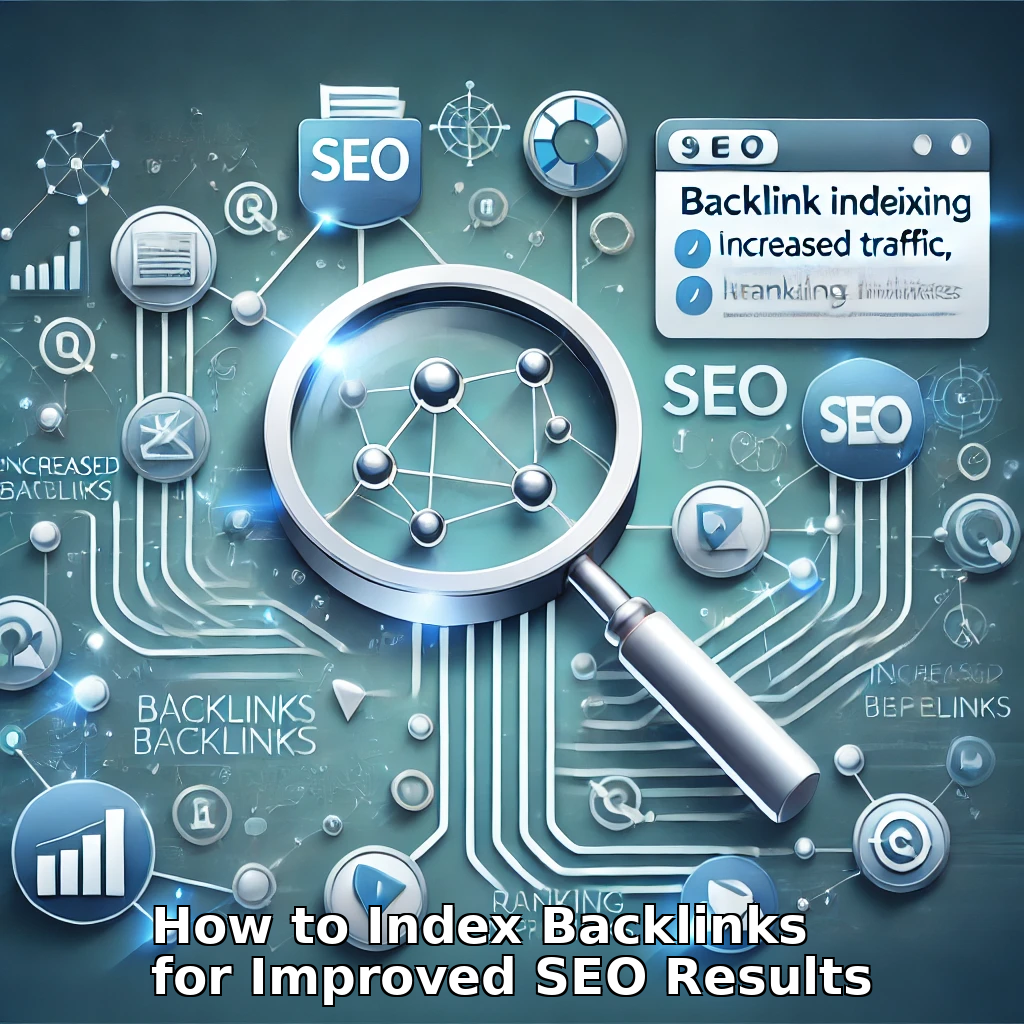How to Index Backlinks for Improved SEO Results
You wonder why some backlinks sit there ignored. Backlinks must be indexed to make a real impact. You want your blood, sweat, and tears noticed, don’t you? That’s where you want to index those links to supercharge your SEO efforts.
The Rapid URL Indexer is an excellent standout tool. It just speeds things up and gets your links in front of Google’s eyes fast. Without indexing, those links are invisible. So why wait?
Take advantage of Rapid URL Indexer and watch your link building go through the roof. Give your backlinks the attention they deserve. This isn’t just about link building; it’s about making them count.
Time to index and jack up!
Understanding Backlink Indexing
Backlink indexing is a vital cog in the SEO machine. It’s the process where search engines crawl and store backlinks in their databases.
When a backlink gets indexed, it’s as if search engines are giving your links a thumbs-up. This indicates that your link is valuable and worth remembering.
Boosting your website’s authority can help you rank better in search results. Understanding that process is critical to achieving that success.
What Is Backlink Indexing?
Backlink indexing is simply the search engine’s recognition and evaluation of links from other sites. Just having links pointing to your site is not sufficient. For those links to count, search engines have to recognize them.
Indexed backlinks contribute to your site’s overall SEO performance and are a key part of ranking algorithms. When your backlink gets indexed by search engines, they’re determining how relevant and high-quality that link is to your content.
However, not all backlinks are indexed. This can affect your SEO efforts because unindexed links don’t help your site earn authority.
Backlinks are crucial for search engines as they serve as indicators of a website’s credibility and authority. When one site links to another, it essentially vouches for the content, suggesting that it is valuable and trustworthy. This endorsement can significantly influence a site’s ranking in search engine results.
Search engines use complex algorithms to analyze these backlinks. They consider various factors, such as the quality of the linking site, the relevance of the content, and the anchor text used in the link. High-quality backlinks from reputable sites can boost a site’s visibility, while low-quality or spammy links can harm its ranking.
Additionally, search engines also look at the quantity of backlinks. A site with a large number of quality backlinks is often seen as more authoritative than one with few links. However, it’s essential to focus on acquiring genuine, relevant backlinks rather than simply increasing the number of links, as this can lead to penalties.
In summary, backlinks play a vital role in how search engines assess and rank websites. They are not just about quantity but also about the quality and relevance of the links. Understanding this can help website owners develop effective strategies for improving their search engine visibility.
- Recognition: They identify links on the web.
- Evaluation: They assess link quality and relevance.
- Indexing: They store valuable links in their databases.
Importance of Indexing Backlinks
Indexed backlinks are essential to boosting a site’s authority and relevancy in search. When your backlinks are properly indexed, you’ll likely see improved search rankings and an uptick in organic traffic.
Indexing is key to how search engines see the importance of your backlinks. Without indexing, even the best backlinks fall flat, providing you with little to no SEO value at all.
Consider these factors when thinking about indexing:
- Indexed links act as votes of confidence from other sites.
- Traffic Increase: They drive referral traffic to your site.
- They improve link equity and speed up content indexing.
How Indexing Impacts SEO
Indexed backlinks directly affect your website’s search engine rankings and visibility. The speed at which they’re indexed can impact how quickly you see results from your SEO efforts.
With indexed links, a healthy backlink profile is key to SEO success. Indexing affects the impact of your link-building campaigns as well as your entire SEO campaigns.
Here’s how indexing plays into SEO:
- Ranking Influence: Indexed links help improve search rankings.
- Timely Strategies: Faster indexing means quicker SEO results.
- Proper indexing gives you an advantage over competitors with unindexed links.
About 60% of websites have unindexed backlinks. Did you know that? This can have a devastating effect on their SEO and search engine rankings.
Using tools like Rapid URL Indexer significantly increases your chances of keeping your backlinks alive. This advantage can provide you with a serious competitive edge in the digital realm.
Methods to Index Backlinks Effectively
Indexing backlinks properly is another way to help increase your website’s search engine authority.
Rapid URL Indexer is a solid tool to make this process easy.
Here, we’ll outline a few ways to have your backlinks indexed quickly for maximum efficiency.
1. Acquire Quality Backlinks
Getting high-quality backlinks is the first step to quality indexing. Focus on links from reputable sites, as these are more likely to be valued by search engines. Ethical link-building practices ensure your backlinks are trusted and indexed faster.
Relevancy is key; make sure linking sites are relevant to your niche to get a better indexing result. By diversifying your backlink sources, you create a strong profile that invites indexing.
For example, if you add backlinks to high-quality articles that are already indexed, Google will find those articles much quicker.
2. Use Google Search Console
Google Search Console (GSC) is another invaluable tool for monitoring and managing your backlinks. Use it to request indexing for your new backlinks and monitor their status.
GSC provides knowledge about how backlinks are indexed, including which links you do and don’t see (and why). Regularly run your links through the URL inspection tool and use those links to stay indexed.
Submitting sitemaps through GSC can also speed up the indexing process.
3. Submit Video Sitemaps
For multimedia content, submitting video sitemaps can improve backlink visibility. Video sitemaps enhance indexing rates because they provide search engines with detailed metadata about your content.
Adding meaningful metadata to these sitemaps expands the ability for indexing to occur. That’s why you should implement video sitemaps into your SEO efforts.
This practice not only increases the indexing of backlinks but also improves the visibility of your content.
4. Leverage Third-Party Tools
Third-party tools can help with monitoring and maintaining the indexing of your backlinks. Look for tools that automate submissions and provide indexing status tracking.
These tools likely include features for detailed backlink analysis, including insights into which links are indexed and why. The analytics from these tools can be leveraged to further refine your backlink strategies for more effective indexation results.
Tools such as Ahrefs, SEMrush, and Moz are great for checking if your backlinks are indexed.
5. Utilize Online Pinging Services
Online pinging services notify search engines about new backlinks, speeding up the discovery and indexing process.
Regularly integrating pinging services into your backlink management practices can improve indexing speed. These services automatically notify search engines when new backlinks are created, which can lead to quicker indexing.
6. Submit RSS Feeds
Submitting RSS feeds allows the search engines to find your new backlinks in no time at all.
RSS feeds help regularly update and index your content, which is an ideal way to promote new backlinks.
Incorporating RSS feeds into your content strategy ensures that your backlinks get indexed efficiently.
7. Create Web 2.0 Links
Web 2.0 sites provide useful links and are simple to index. By creating Web 2.0 links, you can give your backlink profile more diversity and indexing opportunities.
Just make sure that the content on those forum pages is top-notch so you’re maximizing your indexing ability. Utilizing different Web 2.0 properties makes your overall SEO stronger.
8. Publish Press Releases
Publishing press releases results in high-quality backlinks that will be indexed. These backlinks are crucial for improving a website’s search engine ranking and overall visibility.
Press releases gain media attention, which significantly enhances the likelihood of backlinks being indexed. When reputable news outlets pick up a press release, it not only reaches a wider audience but also establishes credibility.
To maximize exposure and indexing, it is essential to write strong press releases targeted at reputable news sites. Crafting a compelling narrative and including relevant information can attract journalists and editors, increasing the chances of publication.
9. Boost with Social Signals
Social signals are substantial when it comes to promoting backlinks and getting pages indexed. Sharing your backlinks on social media can help you easily build those crucial links.
The interaction generated on social media can lead to earlier indexing from search engines. This means that your content can become visible to a wider audience more quickly.
To maximize your efforts, include social media tactics in your backlink-building strategy. By doing so, you can achieve even better results and enhance your overall online presence.
10. Develop Tier 2 Links
Developing tier 2 links supports those primary backlinks, increasing their potential to index. These tier 2 links add authority to primary backlinks, which is crucial for improving their visibility in search engine results.
To be effective, tier 2 link sources should focus on quality rather than quantity. High-quality links can significantly enhance the indexing process of primary backlinks.
Additionally, a tiered linking strategy creates a stronger backlink profile overall. This approach not only boosts the authority of primary links but also contributes to a more robust online presence.
11. Secure Link Insertions
Getting link insertions into relevant content helps the backlinks get indexed. That’s why contextual link placements have a better chance of being indexed because Google prefers contextual backlinks.
Inserting links into established websites is another way you can increase your indexing prospects. It is better to target those high-authority sites.
Here’s a quick list for easy reference:
- Acquire quality backlinks
- Use Google Search Console
- Submit video sitemaps
- Leverage third-party tools
- Utilize online pinging services
- Submit RSS feeds
- Create Web 2.0 links
- Publish press releases
- Boost with social signals
- Develop tier 2 links
- Secure link insertions
Recommended Backlink Indexing Service
If backlinks indexing has been on your mind, Rapid URL Indexer is the answer to your prayers. Not just any service, but the very best service to get your backlinks indexed quickly and easily.
Rapid URL Indexer’s standout features take the speed of indexing and make it even faster. It’s something every online marketer or SEO professional needs, especially those who want to make life easier with their backlinks.
With Rapid URL Indexer, you can forget about the hassle of manual indexing. Instead, you’re primed for an updated SEO adventure that’s sure to deliver better search rankings.
Why Choose Rapid URL Indexer?
When you choose Rapid URL Indexer, you choose a tool that is designed for your use. The benefits are clear. It increases the speed and efficiency of indexing, getting your backlinks picked up by the search engines faster than ever before.
Now picture having an intuitive interface that even newbies can use. Rapid URL Indexer offers just that. Don’t just take our word for it—hundreds of user testimonials and case studies support its effectiveness.
For instance, a digital marketing agency saw an incredible spike in their clients’ SERP positions in a matter of weeks. This fast success demonstrates the tool’s powerful potential.
Benefits of Using Rapid URL Indexer
That’s when you use Rapid URL Indexer to index your links and unlock several key benefits. First, it significantly increases your speed of indexing for new backlinks. This improvement translates to better visibility, enhanced SEO performance, and ultimately, more organic traffic.
One e-commerce brand experienced a significant increase in traffic when their backlinks were indexed quickly through this tool. For hectic site owners, Rapid URL Indexer saves a lot of time.
Say goodbye to countless hours wasted on manual submissions—Rapid URL Indexer takes care of everything.
How to Use Rapid URL Indexer
Here’s a simple guide to get you started with Rapid URL Indexer.
First, it’s important to understand what Rapid URL Indexer is and how it can benefit your online presence. This tool is designed to help you get your URLs indexed more quickly by search engines. By using this service, you can potentially increase the visibility of your website and improve your search rankings.
To begin using Rapid URL Indexer, you will need to create an account. Visit their website and sign up by providing the necessary information. Once your account is set up, you can log in and access the dashboard, where you will find various options for submitting your URLs.
Next, you will want to gather the URLs you wish to index. Make sure to compile a list of the most important pages on your website that you want search engines to discover. This could include your homepage, blog posts, product pages, or any other content you deem valuable.
After you have your URLs ready, navigate to the submission section of Rapid URL Indexer. Here, you can paste your URLs into the provided field. Depending on the plan you choose, there may be limits on the number of URLs you can submit at once, so be mindful of that.
Once you have submitted your URLs, you can monitor their indexing status. Rapid URL Indexer typically provides updates on whether your URLs have been successfully indexed by search engines. This feedback can help you understand the effectiveness of your submissions and adjust your strategy if necessary.
Rapid URL Indexer is a useful tool for enhancing your website’s visibility. By following these steps, you can effectively utilize the service to improve your URL indexing and, ultimately, your search engine rankings.
- Log in and submit your URLs for indexing.
- Ensure URLs are clean and relevant for best results.
- Keep an eye on the indexing progress to gauge success.
Keep in mind that you need to tweak your submissions. It’s not just about linking; it’s about getting them ready to be indexed.
Once you send them in, track results to adapt strategies accordingly. This ongoing process will help you refine your approach and improve overall effectiveness.
Monitoring Backlink Indexing
Therefore, it’s essential to regularly check the indexing status of your backlinks. Why? Because the quality and quantity of your inbound links play a huge role in your page’s authority and relevance. If these links are not indexed, their impact is forfeited.
Think of it like a treasure chest that’s locked away — full of value but inaccessible. Rapid URL Indexer is your key to unlock that value by getting your links indexed quickly. This tool helps you track the indexing of your backlinks like no other.
In fact, in the last six months, it’s dropped our no-index rate from 33% to 7%.
Knowing which backlinks are indexed helps you inform your future SEO strategies. It’s like you’re given a map that reveals which paths lead to success.
Google can take about two weeks to index your backlinks, but this timeline can vary. Monitoring helps you understand these timelines and adjust your strategies accordingly.
If a link isn’t getting indexed, it could be an issue with site structure, domain age, or even content quality. By monitoring these factors, you can adjust your strategy and get the most out of your SEO.
Tracking your backlinks also allows you to quickly identify and address indexing problems. That’s where analytics come in. With a complete dashboard, you can evaluate your backlink indexing efforts and make data-driven choices.
There should be one view that combines website and social stats. This integration helps you identify very quickly what’s working and what’s not. Now armed with this information, you can directly address issues and make sure your backlinks are boosting your SEO efforts.
Check Indexed Status of Backlinks
It’s essential to use tools to check the indexed status of your backlinks. Rapid URL Indexer and other SEO tools let you do this on a regular basis and reveal potential issues.
For example, if a backlink is not indexed, the tool can flag that, allowing you to look into it. It’s like having a security system that notifies you of any weaknesses in your SEO castle.
Ensuring all acquired backlinks are indexed is necessary. This ensures every link helps you rank as an authority on your page.
Keeping a current list of indexed backlinks can be helpful. It becomes a checklist for you, allowing you to properly manage and optimize your SEO strategy.
This proactive approach ensures that you’re not leaving any stone unturned in your quest for better search engine rankings.
Tools for Tracking Backlink Indexing
A range of tools exists to monitor backlink indexing status. Tools such as Ahrefs, SEMrush, and Rapid URL Indexer allow you to effectively track your backlinks.
For example, Ahrefs shows which links are currently indexed and which are not in real-time. This feature is crucial for understanding the performance of your backlinks.
Additionally, these tools provide analytics dashboards, detailed reports, and alerts to keep you updated on any changes. This ensures that you can take timely action to improve your backlink strategy.
A combination of tools can provide you with a comprehensive analysis. Each tool has its own unique features, so using a combination will give you a more thorough view of your link profile.
Real-time updates are not a must but are beneficial. They allow you to adapt quickly to changes in your backlink status. That agility is essential in the rapidly changing SEO landscape, where timely execution can truly move the needle.
Addressing Unindexed Backlinks
Fixing unindexed backlinks is an important part of SEO performance. Start by auditing your backlink profiles regularly to detect any unindexed links. This audit allows you to identify gaps and opportunities for improvement.
Once you’ve identified unindexed links, it’s essential to fix the page content. Ensuring that the content is relevant and high-quality can help improve indexing.
Additionally, consider optimizing page loads to enhance user experience. A faster loading page can positively impact indexing.
If issues persist, you can gently contact webmasters to ask for assistance. Building a good relationship with webmasters can facilitate better communication and resolution of indexing problems.
There are various reasons why backlinks aren’t indexed. Common causes include poor content quality, slow site speed, or even the link being deemed irrelevant by Google.
By understanding why these issues exist, you can fix them. Take the proactive steps needed to increase the likelihood of getting indexed.
Make sure to publish quality content and keep your pages loading quickly. That proactive approach is essential to staying relevant.
Factors Influencing Backlink Indexing
In terms of getting backlinks indexed, Rapid URL Indexer is the answer with Backlink Indexing Tool being the close second.
What exactly guides how search engines determine which backlinks to index? Here’s the lowdown on the most important factors.
First, the authority of the linking domain plays a crucial role. Backlinks from high-authority sites are more likely to be indexed than those from low-quality or spammy sites.
Second, the relevance of the linking page to the content of your site is significant. If the linking page is closely related to your niche, search engines are more inclined to index that backlink.
Additionally, the frequency of updates on the linking site can influence indexing. Websites that are updated regularly tend to have their backlinks indexed more quickly.
Lastly, the overall link structure of your site, including the number of backlinks and their quality, can impact how quickly search engines index your backlinks.
Understanding these factors can help you strategize your backlinking efforts more effectively.
Quality of Backlinks
What matters is the quality of your backlinks. High-quality backlinks, especially those from reputable sites, are indexed more quickly.
Think of it this way: when a well-known site links to you, search engines take notice. That’s because they trust these sites more. A backlink from a reputable news site will likely get indexed faster.
In contrast, a link from some random blog may take longer to be recognized. Why? It’s all about trust and authority.
Relevance is another piece of it. If you target tech, then a link from a tech-focused blog is worth a lot more. A link from a cooking site isn’t going to do you as much good.
Search engines reward you for relevancy, so your link-acquisition efforts must be high-quality. It’s not necessarily quantity; sometimes, a handful of high-quality links can really improve your indexing rate.
Website Authority and Relevance
Backlinks are viewed through the lens of your website’s authority. High authority sites are trusted more and have their backlinks indexed faster.
Search engines assign a ‘crawl budget’ to each website, dictating the speed at which they index links. Essentially, the higher your site’s authority, the more resources search engines would give it.
Strengthen your site’s authority by publishing quality content regularly. Consistently providing valuable information not only attracts visitors but also encourages other sites to link back to you. This can significantly enhance your online presence and credibility.
In addition, networking with reputable sites is crucial. Building relationships with other authoritative websites can lead to valuable backlinks and collaborations. These connections can help boost your site’s visibility and trustworthiness in your niche.
Improving your site structure is another essential step. A well-organized site makes it easier for search engines to crawl and index your content. This can enhance user experience and increase the likelihood of your backlinks being indexed effectively.
All of these efforts can go a long way to help increase your chances of getting your backlinks indexed. By focusing on quality content, networking, and site structure, you create a solid foundation for your site’s authority and search engine performance.
Frequency of Content Updates
Updating your content regularly can make a huge difference. Even search engines love fresh content, and that means better indexing.
An active content schedule doesn’t just keep your audience engaged; it also improves backlink performance. Picture it like this: each new piece of content is a beacon that draws search engine crawlers to your site.
Site speed and domain age also factor in, as older, faster sites tend to get indexed faster. This means that if your website has been around for a while and loads quickly, it is more likely to be recognized by search engines promptly.
Social media platforms, such as Twitter and YouTube, can accelerate this indexing process. By sharing your content on these platforms, you can increase its visibility and encourage quicker indexing by search engines.
To maximize this advantage, keep your content fresh and engaging. Regular updates and new posts can help maintain interest and relevance.
Additionally, incorporate social media into your backlink strategy. Building links from these platforms can enhance your site’s authority and improve its overall search engine performance.
Here’s a quick list of tips to remember:
- Regularly update your content to attract search engine crawlers.
- Use social media to boost your backlink visibility and indexability.
- Aim for high-quality, relevant links to enhance your chances of being indexed.
Conclusion
To increase your website authority, index those backlinks like a boss. You are an editor and you want a tool that does the job right. Rapid URL Indexer does this, and it does so with speed and precision. You’re not throwing darts in the dark here. As a result, with this tool, you know your backlinks get seen by search engines.
Don’t let those valuable links go to waste. Use Rapid URL Indexer to make them traffic magnets. It’s your secret sauce for online success. Want to see your SEO efforts pay off? Get on board with Rapid URL Indexer now. Your rankings will thank you.
Take advantage of this opportunity. Make every single backlink worth it. Start indexing smarter today with Rapid URL Indexer.




